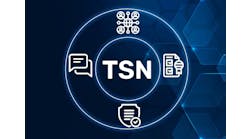Mike Bacidore is the editor in chief for Control Design magazine. He is an award-winning columnist, earning a Gold Regional Award and a Silver National Award from the American Society of Business Publication Editors. Email him at [email protected].
Car-makers embraced deterministic control for in-vehicle and out-of-vehicle systems years ago. This is largely what has driven the transformation of audio video bridging into time sensitive networking.
Automobiles have different latency-sensitive applications than manufacturing does, but the two are learning from one another in their respective pursuits of TSN via deterministic Ethernet.
“The automotive industry can be a strong partner to get to a global and unified standard for a deterministic communication,” advises Dipl. Ing. André Hennecke, researcher at DFKI, a research center in Kaiserslautern, Germany. “This can be used not only in the automotive or manufacturing, but also in all IoT sectors. Stream reservation and real-time scheduling methods have long played an important role in industrial Ethernet solutions such as Profinet. TSN is more adapted from manufacturing than the other way around. Until now, the manufacturing industry couldn’t reach an agreement for a uniform and interoperable communication.”
With the automotive industry as a pioneer in using TSN, manufacturing will also move in this direction, Hennecke predicts.
“TSN is another step in the journey,” says Paul Brooks, business development manager at Rockwell Automation. “All of the previous steps allowed companies to solve applications with Ethernet. TSN will allow more applications. The industrial companies have been some of the earliest companies to engage in the move from what was previously AV bridging to TSN as a more industry-independent name.”
Also read: Why deterministic Ethernet matters to manufacturing
Networking technologies often migrate from one sector to another, as complimentary solutions and benefits for alternative applications become apparent. “This has been demonstrated in the case of the CANbus protocol, which after being developed initially for in-vehicle communication was widely adopted for use as a fieldbus in industrial automation,” says Markus Plankensteiner, vice president, sales industrial, North America, and global alliance manager, TTTech Computertechnik. “The transition was helped by commercial factors, such as the enviable efficiencies of scale found in the automotive industry, which led to the availability of low-cost CAN controllers and processors for industrial customers. This process can be seen again today with deterministic Ethernet technology, and it’s clear that the best result for all involved would be a TSN standard that straddles both automotive and industrial applications.”
The industrial sector requires TSN to provide for aspects, such as scaling systems to larger subnets and adding devices, that aren’t fully represented by what’s already been done in the automotive industry, says Steve Zuponcic, technology manager at Rockwell Automation. “The idea of TSN is being able to provide more solutions, but the industrial sector will expand its capabilities,” he predicts.
The development of TSN started with calls for interest (CFIs) in 2012, when several companies from the automotive, manufacturing and semiconductor domain asked the IEEE for a joint development of an enhancement of Ethernet toward real-time communication, explains Dr. Michael Hoffmeister, portfolio manager, software, at Festo. “Although the way of implementing TSN in a vehicle or a machine might be different, both industry domains benefit from each other in terms of higher volume for Ethernet devices and a higher maturity for the technology itself,” he says.
The needs of automation and the needs of in-car entertainment and vision systems are somewhat related, sharing only the need to transmit and receive information in a timely manner, explains Joey Stubbs, P.E., North American representative, EtherCAT Technology Group.
“However, automation requirements are typically stricter,” he notes. “For example, industrial or surgical robotics or complex process controls of pharmaceuticals have much different needs than driverless vehicles or AV systems. That being said, there will undoubtedly be innovations introduced in the subgroups of TSN that will be of interest to manufacturing. However, manufacturing has an 11-plus-year headstart using industrial Ethernet as a fieldbus for automation devices and systems. In reality, the use of industrial Ethernet is most likely driving the interest of the automotive industry, not the other way around.”






